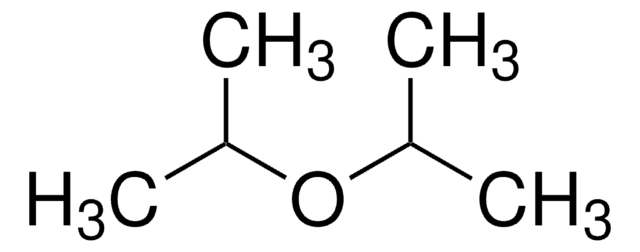38270
Diisopropyl ether
puriss. p.a., ≥98.5% (GC)
Synonym(s):
Isopropyl ether
About This Item
Recommended Products
vapor density
3.5 (vs air)
Quality Level
vapor pressure
120 mmHg ( 20 °C)
grade
puriss. p.a.
Assay
≥98.5% (GC)
form
liquid
autoignition temp.
827 °F
contains
~0.001% 2,6-di-tert-butyl-4-methylphenol as stabilizer
expl. lim.
1-21 %, 100 °F
impurities
≤0.001% peroxides (as H2O2)
≤0.005% free acid (as C2H5COOH)
≤0.1% water
≤0.5% isopropanol (GC)
evapn. residue
≤0.002%
refractive index
n20/D 1.367 (lit.)
n20/D 1.368
bp
68-69 °C (lit.)
mp
−85 °C (lit.)
density
0.724 g/mL at 20 °C
0.725 g/mL at 25 °C (lit.)
cation traces
Al: ≤0.5 mg/kg
Ba: ≤0.1 mg/kg
Bi: ≤0.1 mg/kg
Ca: ≤0.5 mg/kg
Cd: ≤0.05 mg/kg
Co: ≤0.02 mg/kg
Cr: ≤0.02 mg/kg
Cu: ≤0.02 mg/kg
Fe: ≤0.1 mg/kg
K: ≤0.5 mg/kg
Li: ≤0.1 mg/kg
Mg: ≤0.1 mg/kg
Mn: ≤0.02 mg/kg
Mo: ≤0.1 mg/kg
Na: ≤0.5 mg/kg
Ni: ≤0.02 mg/kg
Pb: ≤0.1 mg/kg
Sr: ≤0.1 mg/kg
Zn: ≤0.1 mg/kg
SMILES string
CC(C)OC(C)C
InChI
1S/C6H14O/c1-5(2)7-6(3)4/h5-6H,1-4H3
InChI key
ZAFNJMIOTHYJRJ-UHFFFAOYSA-N
Looking for similar products? Visit Product Comparison Guide
General description
Application
Signal Word
Danger
Hazard Statements
Precautionary Statements
Hazard Classifications
Flam. Liq. 2 - STOT SE 3
Target Organs
Respiratory system
Supplementary Hazards
Storage Class Code
3 - Flammable liquids
WGK
WGK 1
Flash Point(F)
-20.2 °F - closed cup
Flash Point(C)
-29 °C - closed cup
Choose from one of the most recent versions:
Already Own This Product?
Find documentation for the products that you have recently purchased in the Document Library.
Our team of scientists has experience in all areas of research including Life Science, Material Science, Chemical Synthesis, Chromatography, Analytical and many others.
Contact Technical Service




